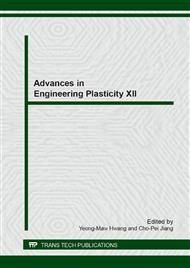p.50
p.57
p.62
p.68
p.74
p.81
p.85
p.91
p.97
Computational Simulation of Micro- to Macroscopic Deformation Behavior of Cavitated Rubber Blended Amorphous Polymer Using Second-Order Homogenization Method
Abstract:
To evaluate the effect of the size of the microstructure on the mechanical property of the cavitated rubber blended (voided) amorphous polymer, the FEM simulation based on the rate form second-order homogenization method, in which rates of the macroscopic strain and strain gradient are given to the microstructure, was performed. Computational simulations of micro-to macroscopic deformation behaviors of amorphous polymers including different sizes and volume fractions of the voids were performed. Non-affine molecular chain network theory was employed to represent the inelastic deformation behavior of the amorphous polymer matrix. With the increase in the volume fraction of the void, decrease and periodical fluctuation of stress and localized deformation in the macroscopic field were observed, and were more emphasized with the increase in the size of the void. These results were closely related to the non-uniform deformation and volume increase of the void in the microscopic field.
Info:
Periodical:
Pages:
74-80
Citation:
Online since:
August 2014
Authors:
Keywords:
Price:
Сopyright:
© 2015 Trans Tech Publications Ltd. All Rights Reserved
Share:
Citation:


